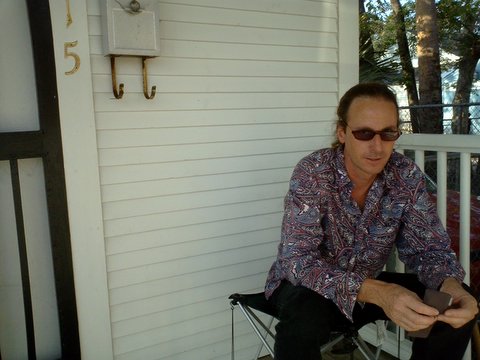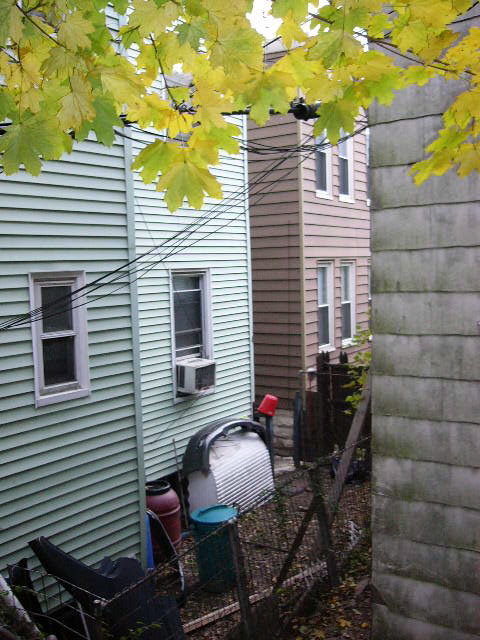Schwarz
View current page
...more recent posts
Atlanta — The Italian architect Renzo Piano is in the process of rewriting the book on American museum architecture. Well, it might be more accurate to say he's rewriting the book on museum expansions: His firm, Renzo Piano Building Workshop, has additions in the works at a remarkable number of the most prominent museums in the country, including the Whitney in New York, the Gardner in Boston and the Art Institute of Chicago. And, of course, there's his reconfiguration of the Los Angeles County Museum of Art and its muddled collection of buildings along Wilshire Boulevard, the first phase of which will open in 2007.
Planners from around the country have already descended on the Gulf Coast region, beginning a series of charrettes to shape the future of land use and community development in the devastated region. Yet are the local residents -- especially those who need the most help -- ready to make plans? Leonardo Vazquez argues that more careful, long-term planning is needed to ensure that current residents and refugees alike are given the stake and voice they need in the rebuilding efforts.
The only Prairie-style house Frank Lloyd Wright designed and built in Ohio opened its doors to the public for the first time on Oct. 15 after undergoing a $5.8 million restoration.
Francie Rehwald wanted her mountainside house to be environmentally friendly and to be "feminine," to have curves. "I'm a gal," says the 60-year-old retiree.
Her architect had an idea: Buy a junked 747 and cut it apart. Turn the wings into a roof, the nose into a meditation temple. Use the remaining scrap to build six more buildings, including a barn for rare animals. He made a sketch.
Rebuilding any city is a complicated business. As soon as the flood waters began to subside in New Orleans, suggestions for what to do with a devastated city started coming from everywhere. Two local citizens suggest twenty points of entry.via metropolis
speaking of scams. some may know that schwarz was born in new orleans way back in 1955. my dad told me about the the "I bet i know where you got dem shoes" routine, so i was prepared when i was walking down the bowery one day and this guy came up and said "I bet i know where you got dem shoes."
you never know whats in a factory sealed box. i know of several people who bought a factory wrapped brick in a sony box off the street here in nyc in the 80's. im sure that scam is still around and what they really bought was an invaluable life lesson for one hundred dollars which is cheep if you dont do it twice. buyer beware. check out this nasty factory wrapped shit from a new orleans metro blogger.

yes, we are following fellow blogger Jim Louis's posted reports from new orleans on his email from nola blog.
we are also posting the digital photo e.mail attachments he's sending in. mostly images of his neighborhood in the fourth ward.
NEW ORLEANS, Nov. 7 - Something once unimaginable has begun to happen here: the United Parcel Service is delivering again downtown. At Langenstein's grocery, celery and pork chops are moving out the door, and revelers spill out of the Magazine Street bars on Friday nights.
But just a mile away, workers are struggling to restore some flood protection to the city, which would barely stay dry in even a modest tropical storm. Tens of thousands of homeowners, facing six-figure repair bills for their rotting houses, are unlikely to get more than a fraction of that from the government. As phones ring in empty offices, even the shrimp business can barely find customers, and the economy remains comatose.
[...]
Will New Orleans be granted a vastly strengthened flood protection system - at a cost of up to $20 billion - or will it be told to allow low-lying residential neighborhoods to return to marshland? Will the city have to take control of thousands of houses to restore them - at a cost that no one has calculated - or will it have to tell thousands of evacuated residents not to return?
Every major decision seems to rely on another decision that has to be made first, and no one has stepped in to announce what the city will do and break the cycle of uncertainty. Many residents and business owners will not return and invest without an assurance of flood protection, for example. But workers who could rebuild the levees and much of the rest of the city are hampered by the lack of housing.
The definition of art is not something that anyone would lightly undertake. Nor would it normally be left to a US customs official to decide. But that is exactly what happened in October 1926 when Marcel Duchamp arrived on the New York dockside accompanying 20 modernist masterpieces from Brancusi's studio that were destined for selling exhibitions in New York and Chicago. Duchamp at that time had given up art in favour of chess, and was trying to eke out a living by art-dealing with his friend Henri-Pierre Roché, mainly in Brancusi.
The point was that ordinary merchandise was subject to duty at 40 per cent, while art was not. And the customs official on duty at the time happened to be an amateur sculptor – just the sort of person to have bumptiously confident views about matters aesthetic. He took one look at the Brancusis, concluded that they weren't art, and levied $4,000 duty.
Two months after Hurricane Katrina displaced more than 1 million people, problems with federal housing aid threaten to spawn a new wave of homelessness.
In Texas, thousands of evacuees who found shelter in apartments face eviction threats because rents are going unpaid.
In Louisiana, some evacuees are beginning to show up in homeless shelters because they haven't received federal aid or don't know how to get it.
Advocates for the poor say the situation will worsen this winter.
“They are the poorest folks … and they are the ones who are going to be left with nothing,” says Sheila Crowley, president of the National Low Income Housing Coalition. “It's going to show up at homeless shelters this winter.”
The housing crunch could get tighter in November, because the Federal Emergency Management Agency (FEMA) wants to move an estimated 200,000 Katrina evacuees out of hotels as soon as possible.
That increases the need for apartments, trailers and mobile homes.
Pressure is building on FEMA to alter its policies. Two programs provide rent money directly to evacuees or reimburse local governments. But many evacuees have not received the cash or have used it for other needs. And some cities refuse to spend their own money up front.
It was 1895. Wright, twenty-eight, had only recently set up his own practice, after being fired by Louis Sullivan for taking on outside commissions on the sly. [Marion] Mahony, herself, had recently been dismissed from the employ of her cousin, Chicago architect Dwight Perkins, during an economic downturn.
It can be argued that it was Mahony's distinctive renderings that created the public face that helped Wright's work command attention throughout the world. It could be speculated that Wright's work, itself, was influenced by Mahony's role in the spirited exchanges of ideas that went on in his studio, yet she is one a series of pioneering women architects and designers who have disappeared into the deep shadow of their male associates - Lill Reich in that of Mies van der Rohe, Aino Aalto in that of Alvar Aalto, and Mahony, in that of both Wright and her husband Walter Burley Griffin. Observes Jeanne Gang, part of a very different and more indelible generation of women architects, “They seem to get erased.”
rip e stewart williams desert modernist
Streaking at sporting events is generally thought to have begun in 1974, when a 25- year-old Australian accountant named Michael O'Brien ran naked onto the pitch at Twickenham Stadium in London during a soccer match between France and England. That event was being televised live, but it was perhaps a still image in the papers of an English bobby covering Mr. O'Brien's private parts that is most remembered.
43-man squamish
1st sunday nov 05 jcnj
The Architects Collaborative (TAC)
toh goes to visit six moon hill
Robert Philip's Performing Music in the Age of Recording is a brilliant analysis of how this has affected performance style. It is also incidentally, for much of the time, the best account I know of how musical life in general has changed since the introduction of vinyl and long-playing records in the 1950s, which made it possible for records to invade everyone's home. But it starts even further back with the end of the nineteenth century, when recording was invented by Thomas Edison, who recited "Mary Had a Little Lamb" into his new machine. The book is full of fascinating detail cogently presented on rehearsal practices and standards, recording on piano rolls, the different instruments used in orchestras, the way records are edited, and the contrasting musical ideals of performers. Philip is large-minded, tolerant, and sympathetic to various positions, and consistently judicious.
His main thesis is that recording has directed performance style into a search for greater precision and perfection, with a consequent loss of spontaneity and warmth. Various expressive devices once common in the early twentieth century have been almost outlawed: "portamento" (sliding from one note to another on a stringed instrument); playing the piano with the hands not quite together (Philip calls this dislocation); arpeggiating chords (not playing all the notes of the chord at the same time but one after another), and flexibility of tempo.
In retrospect, the fate of the Freedom Center may have been sealed three years ago with the decision to create a clearly defined parallelogram, bordered by four streets, in which both the memorial and a cultural complex were to sit. Since this was the site of the twin towers, it may have been inevitable that the block would be seen as hallowed.
Gretchen Dykstra, the president of the memorial foundation, which will build and own the memorial and cultural buildings, said the governor had now "provided clear direction that the memorial quadrant should be devoted to telling the story of Sept. 11th."
"Memorial quadrant"?? If only the limits of this farce were as clearly delineated. How is that quadrant any more "hallowed" than the other eight-plus acres of the site? It seems like only yesterday that the "footprints" were the sacred squares that had to be defended at all costs.
How and by whom was this quadrant defined? By the MTA, who cordoned it off in an effort to keep its sacred revenue stream as more than just a memory. And to whom are the MTA and its proxy, the LMDC, beholden? To the governor who just undid their three year's work on the IFC and the master plan "in a stroke."


